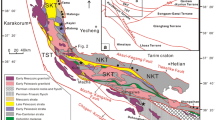Abstract
Supergene jarosite is widely distributed in weathering profiles derived from hypogene sulfide ores. Precise 40Ar/39Ar dating and determination of hydrogen and oxygen isotopes of supergene jarosite can not only place tight constraints on the timing and history of continental weathering and supergene enrichment of sulfide ore deposits, but also shed significant insights into paleoclimatic conditions and tectonic uplift responsible for the weathering. In this paper, we present a preliminary study of 40Ar/39Ar geochronology and stable isotope geochemistry of supergene jarosite from the early Paleozoic Zheyaoshan volcanic-hosted massive sulfide deposit of the Baiyin ore field located in the eastern portion of the Qilian Mountain along the northeastern (NE) margin of the Tibetan Plateau in an attempt to better understand the climatic conditions prevailed during the pervasive weathering in the region. Jarosite from the Zheyaoshan mining area occurs either as gravels within alluvial deposits over low-relief flat-top hills or cm-wide veins crosscutting weathered sulfide ores or their wall rocks. The gravels consist of massive jarosite aggregates with tabular crystal morphology and contain 8.21 wt%–8.31 wt% K2O on average. Two jarosite grains extracted from the gravels (08-02-2 and 08-02-5) yield well-defined 40Ar/39Ar plateau ages of 37.1 ± 0.3 and 41.2 ± 0.4 Ma (2σ), respectively. They have δD values of −133 ‰ and −156 ‰, and \({\delta ^{18}}{{\rm{O}}_{{\rm{S}}{{\rm{O}}_4}}}\) values of 2.6 ‰ and 2.5 ‰. The vein-type jarosite consists of hexagonal pyramid crystals and contains much lower K2O, averaging at 2.44 wt%–2.72 wt%. Two jarosite veins (06-16-3 and 06-16-4) yield similar plateau ages of 3.2 ± 0.1 and 3.3 ± 0.1 Ma (2σ), respectively. These jarosite veins have δD values of −158 ‰ and −160 ‰, and \({\delta ^{18}}{{\rm{O}}_{{\rm{S}}{{\rm{O}}_4}}}\) values of 2.8 ‰ and 2.5 ‰. The 40Ar/39Ar ages indicate that sulfide ores of the Zheyaoshan deposit must have been brought to the surface since the late Eocene, and subsequently subjected to prolonged oxidation and supergene enrichment. The precipitation and preservation of jarosite in weathering profiles indicate that arid–semiarid climatic conditions must have been prevailed since the late Eocene. The hydrogen and oxygen isotopes of the jarosite further point to variation of climatic conditions in the area, with the Pliocene being slightly cooler relative to the late Eocene. Given that weathering profiles overlying sulfide ore deposits are widely distributed along the Qilian Mountain, systematic studies of 40Ar/39Ar geochronology and stable isotope geochemistry of jarosite-group minerals from these profiles would provide valuable information on the timing and evolution of regional tectonic uplift, paleoclimatic changes, and supergene mineralization in this mountainous belt along the NE edge of the Tibetan Plateau.






Similar content being viewed by others
References
Stoffregen RE, Alpers CN, Jambor JL (2000) Alunite-jarosite crystallography, thermodynamics, and geochronology. Rev Mineral Geochem 40:453–479
Vasconcelos PM (1999) K–Ar and 40Ar/39Ar Geochronology of weathering processes. Annu Rev Earth Planet Sci 27:183–229
Vasconcelos PM, Brimhall GH, Becker TA et al (1994) 40Ar/39Ar analysis of supergene jarosite and alunite: Implications to the paleoweathering history of the western USA and west Africa. Geochim Cosmochim Acta 58:401–420
Vasconcelos PM, Conroy M (2003) Geochronology of weathering and landscape evolution, Dugald River Valley, NW Queensland, Australia. Geochim Cosmochim Acta 67:2913–2930
Alpers CN, Brimhall GH (1989) Paleohydrologic evolution and geochemical dynamics of cumulative supergene metal enrichment at La Escondida, Atacama Desert, northern Chile. Econ Geol 84:229–255
Arehart GB, O’Neil JR (1993) D/H ratios of supergene alunite as an indicator of paleoclimate in continental settings. In: Swart PK, Lohmann KC, Mckenzie J et al (eds) Climate change in continental isotopic records. Geophysical monograph series, vol 78. American Geophysical Union, Washington, pp 277–284
Li XL (1959) Studies on jarosite minerals from the sulfide deposits of Qilian orogen. Chin J Geol 26–28 (in Chinese)
Li XL (1960) Studies on the oxidation zones of polymetallic deposits in arid regions in northwestern China. Chin J Geol 1:14–24 (in Chinese)
Tu GC, Li XL (1963) Studies on the characteristic features of the oxidation zone of the sulphite deposits in arid to extremely arid regions (with special reference to observations obtained from five sulphide deposits in the northwestern China). Acta Geol Sin 43:361–377 (in Chinese)
Hou ZQ, Zaw K, Rona P et al (2008) Geology, fluid inclusions, and oxygen isotope geochemistry of the Baiyinchang pipe-style volcanic-hosted massive sulfide Cu deposit in Gansu Province, northwestern China. Econ Geol 103:269–292
Scott KM, Ashley PM, Lawie DC (2001) The geochemistry, mineralogy and maturity of gossans derived from volcanogenic Zn–Pb–Cu deposits of the eastern Lachlan Fold Belt, NSW, Australia. J Geochem Explor 72:169–191
Fleck RJ, Sutter JF, Elliot DH (1977) Interpretation of discordant 40Ar/39Ar age-spectra of Mesozoic tholeiites from Antarctica. Geochim Cosmochim Acta 41:15–32
Kuiper KF, Deino A, Hilgen FJ et al (2008) Synchronizing rock clocks of Earth history. Science 320:500–504
Wasserman MD, Rye RO, Bethke PM et al (1992) Methods for separation and total stable isotope analysis of alunite. Open-File Report. U.S. Geological Survey, pp 92–99
Lee JY, Marti K, Severinghaus JP et al (2006) A redetermination of the isotopic abundances of atmospheric Ar. Geochim Cosmochim Acta 70:4507–4512
Rye RO, Alpers CN (1997) The stable isotope geochemistry of jarosite. Open-File Report. U.S. Geological Survey, pp 88–97
Seal RR, Alpers CN, Rye RO (2000) Stable isotope systematics of sulfate minerals. Rev Mineral Geochem 40:541–602
Arancibia G, Matthews SJ, Pérez de Arce C (2006) K–Ar and 40Ar/39Ar Geochronology of supergene processes in the Atacama Desert, northern Chile: tectonic and climatic relations. J Geol Soc (London, UK) 163:107–118
Bissig T, Riquelme R (2010) Andean uplift and climate evolution in the southern Atacama Desert deduced from geomorphology and supergene alunite-group minerals. Earth Planet Sci Lett 299:447–457
Bouzari F, Clark AH (2002) Anatomy, evolution, and metallogenic significance of the supergene orebody of the Cerro Colorado porphyry copper deposit, I Región, northern Chile. Econ Geol 97:1701–1740
Mote TI, Becker TA, Renne P et al (2001) Chronology of exotic mineralization at El Salvador, Chile, by 40Ar/39Ar dating of copper wad and supergene alunite. Econ Geol 96:351–366
Quang CX, Clark AH, Lee JKW et al (2003) 40Ar/39Ar ages of hypogene and supergene mineralization in the Cerro Verde-Santa Rosa porphyry Cu–Mo cluster, Arequipa, Peru. Econ Geol 98:1683–1696
Quang CX, Clark AH, Lee JKW et al (2005) Response of supergene processes to episodic Cenozoic uplift, pediment erosion, and ignimbrite eruption in the porphyry copper province of southern Peru. Econ Geol 100:87–114
Li ZP, Peng LG, Ren YX et al (2000) Petrology of volcanoclastic rocks from Baiyinchang and Palaeo-marine volcanism. Acta Petrol Sin 16:183–190 (in Chinese)
Dansgaard W (1964) Stable isotopes in precipitation. Tellus 16:436–468
Pang ZH, Kong YL, Froehlich K et al (2011) Processes affecting isotopes in precipitation of an arid region. Tellus B 63:352–359
Rye RO, Bethke PM, Wasserman MD (1992) The stable isotope geochemistry of acid sulfate alteration. Econ Geol 87:225–262
Zachos J, Pagani M, Sloan L et al (2001) Trends, rhythms, and aberrations in global climate 65 Ma to present. Science 292:686–693
Bird MI, Chivas AR, McDougall I (1990) An isotopic study of surficial alunite in Australia. 2. Potassium–argon geochronology. Chem Geol 80:133–145
Sillitoe RH (2005) Supergene oxidized and enriched porphyry copper and related deposits. In: Hedenquist JW, Thompson JFH, Goldfarb RJ et al (eds) Economic geology 100th anniversary volume (1905–2005). Society of Economic Geology, Littleton, pp 723–768
Guo ZT, Ruddiman WF, Hao QZ et al (2002) Onset of Asian desertification by 22 Myr ago inferred from loess deposits in China. Nature 416:159–163
Liu TS, Zheng MP, Guo ZT et al (1998) Initiation and evolution of the Asian monsoon system timely coupled with the ice-sheet growth and the tectonic movements in Asia. Quat Sci 3:194–204 (in Chinese)
Sun XJ, Wang PX (2005) How old is the Asian monsoon system?—Palaeobotanical records from China. Palaeogeogr Palaeoclimatol Palaeoecol 222:181–222
Rea DK, Snoeckx H, Joseph LH (1998) Late Cenozoic eolian deposition in the North Pacific: Asian drying, Tibetan uplift, and cooling of the northern Hemisphere. Paleoceanography 13:215–224
Rea DK, Leinen M, Janecek TR (1985) Geologic approach to the long-term history of atmospheric circulation. Science 227:721–725
Acknowledgments
Professor Paulo M. Vasconcelos from UQ-AGES and Drs. Robert O. Rye and Michael A. Cosca from USGS (Denver) are thanked for providing access to 40Ar/39Ar dating and stable isotope analysis facilities. This manuscript has benefited from constructive reviews by two anonymous reviewers. Discussion with Drs. Xiaodong Deng, Xianhua Li, Gangjian Wei, and Qiuli Li has been helpful. This work was supported by the National Natural Science Foundation of China (41325007 and 40573021) and the Program for New Century Excellent Talents in University (NCET-05-0665).
Author information
Authors and Affiliations
Corresponding author
About this article
Cite this article
Chen, L., Li, J. 40Ar/39Ar ages and stable isotopes of supergene jarosite from the Baiyin VHMS ore field, NE Tibetan Plateau with paleoclimatic implications. Chin. Sci. Bull. 59, 2999–3009 (2014). https://doi.org/10.1007/s11434-014-0276-8
Received:
Accepted:
Published:
Issue Date:
DOI: https://doi.org/10.1007/s11434-014-0276-8




